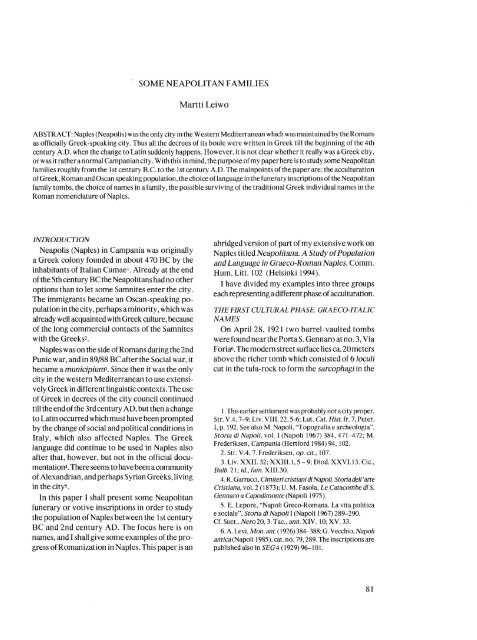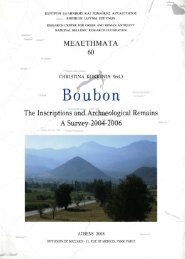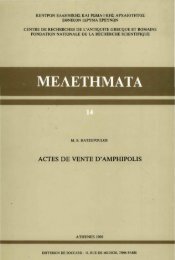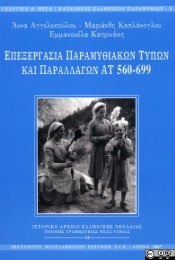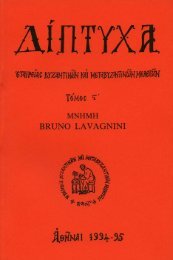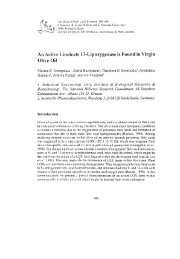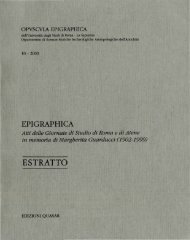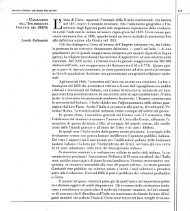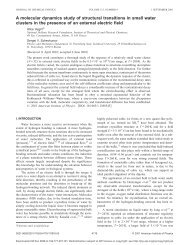Roman onomastics in the Greek East: social and political aspects ...
Roman onomastics in the Greek East: social and political aspects ...
Roman onomastics in the Greek East: social and political aspects ...
Create successful ePaper yourself
Turn your PDF publications into a flip-book with our unique Google optimized e-Paper software.
SOME NEAPOLITAN FAMILIES<br />
Mariti Leiwo<br />
ABSTRACT: Naples (Neapolis) was <strong>the</strong> only city <strong>in</strong> <strong>the</strong> Western Mediterranean which was ma<strong>in</strong>ta<strong>in</strong>ed by <strong>the</strong> <strong>Roman</strong>s<br />
as officially <strong>Greek</strong>-speak<strong>in</strong>g city. Thus all <strong>the</strong> decrees of its boule were written <strong>in</strong> <strong>Greek</strong> till <strong>the</strong> beg<strong>in</strong>n<strong>in</strong>g of <strong>the</strong> 4th<br />
century A.D. when <strong>the</strong> change to Lat<strong>in</strong> suddenly happens. However, it is not clear whe<strong>the</strong>r it really was a <strong>Greek</strong> city,<br />
or was it ra<strong>the</strong>r a normal Campanian city. With this <strong>in</strong> m<strong>in</strong>d, <strong>the</strong> purpose of my paper here is to study some Neapolitan<br />
families roughly from <strong>the</strong> 1st century B.C. to <strong>the</strong> 1st century A.D. The ma<strong>in</strong>po<strong>in</strong>ts of <strong>the</strong> paper are: <strong>the</strong> acculturation<br />
of <strong>Greek</strong>, <strong>Roman</strong> <strong>and</strong> Oscan speak<strong>in</strong>g population, <strong>the</strong> choice oflanguage <strong>in</strong> <strong>the</strong> funerary <strong>in</strong>scriptions of <strong>the</strong> Neapolitan<br />
family tombs, <strong>the</strong> choice of names <strong>in</strong> a family, <strong>the</strong> possible surviv<strong>in</strong>g of <strong>the</strong> traditional <strong>Greek</strong> <strong>in</strong>dividual names <strong>in</strong> <strong>the</strong><br />
<strong>Roman</strong> nomenclature of Naples.<br />
INTRODUCTION<br />
Neapolis (Naples) <strong>in</strong> Campania was orig<strong>in</strong>ally<br />
a <strong>Greek</strong> colony founded <strong>in</strong> about 470 BC by <strong>the</strong><br />
<strong>in</strong>habitants of Italian Cumae 1 . Already at <strong>the</strong> end<br />
of <strong>the</strong> 5th century BC <strong>the</strong> Neapolitans had no o<strong>the</strong>r<br />
options than to let some Samnites enter <strong>the</strong> city.<br />
The immigrants became an Oscan-speak<strong>in</strong>g population<br />
<strong>in</strong> <strong>the</strong> city, perhaps a m<strong>in</strong>ority, which was<br />
already well acqua<strong>in</strong>ted with <strong>Greek</strong> culture, because<br />
of <strong>the</strong> long commercial contacts of <strong>the</strong> Samnites<br />
with <strong>the</strong> <strong>Greek</strong>s 2 .<br />
Naples was on <strong>the</strong> side of <strong>Roman</strong>s dur<strong>in</strong>g <strong>the</strong> 2nd<br />
Punic war, <strong>and</strong> <strong>in</strong> 89/88 BC after <strong>the</strong> Social war, it<br />
became a municipium^. S<strong>in</strong>ce <strong>the</strong>n it was <strong>the</strong> only<br />
city <strong>in</strong> <strong>the</strong> western Mediterranean to use extensively<br />
<strong>Greek</strong> <strong>in</strong> different l<strong>in</strong>guistic contexts. The use<br />
of <strong>Greek</strong> <strong>in</strong> decrees of <strong>the</strong> city council cont<strong>in</strong>ued<br />
till <strong>the</strong> end of <strong>the</strong> 3rd century AD, but <strong>the</strong>n a change<br />
to Lat<strong>in</strong> occurred which must have been prompted<br />
by <strong>the</strong> change of <strong>social</strong> <strong>and</strong> <strong>political</strong> conditions <strong>in</strong><br />
Italy, which also affected Naples. The <strong>Greek</strong><br />
language did cont<strong>in</strong>ue to be used <strong>in</strong> Naples also<br />
after that, however, but not <strong>in</strong> <strong>the</strong> official documentation<br />
4 . There seems to have been a community<br />
of Alex<strong>and</strong>rian, <strong>and</strong> perhaps Syrian <strong>Greek</strong>s, liv<strong>in</strong>g<br />
<strong>in</strong> <strong>the</strong> city 5 .<br />
In this paper I shall present some Neapolitan<br />
funerary or votive <strong>in</strong>scriptions <strong>in</strong> order to study<br />
<strong>the</strong> population of Naples between <strong>the</strong> 1st century<br />
BC <strong>and</strong> 2nd century AD. The focus here is on<br />
names, <strong>and</strong> I shall give some examples of <strong>the</strong> progress<br />
of <strong>Roman</strong>ization <strong>in</strong> Naples. This paper is an<br />
abridged version of part of my extensive work on<br />
Naples titled Neapolitana. A Study of Population<br />
<strong>and</strong> Language <strong>in</strong> Graeco-<strong>Roman</strong> Naples. Comm.<br />
Hum. Litt. 102 (Hels<strong>in</strong>ki 1994).<br />
I have divided my examples <strong>in</strong>to three groups<br />
each represent<strong>in</strong>g a different phase of acculturation.<br />
THE FIRST CULTURAL PHASE. GRAECO-ITALIC<br />
NAMES<br />
On April 28, 1921 two barrel-vaulted tombs<br />
were found near <strong>the</strong> Porta S. Gennaro at no. 3, Via<br />
Foria 6 . The modern street surface lies ca. 20 meters<br />
above <strong>the</strong> richer tomb which consisted of 6 loculi<br />
cut <strong>in</strong> <strong>the</strong> tufa-rock to form <strong>the</strong> sarcophagi m <strong>the</strong><br />
1. This earlier settlement was probably not a city proper.<br />
Str. V.4,7-9; Liv. VIII. 22,5-6; Lut. Cat. Hist. fr. 7, Peter,<br />
I, p. 192. See also M. Napoli, "Topografia e archeologia",<br />
Storia di Napoli, voi. I (Napoli 1967) 384, 471^172; M.<br />
Frederiksen, Campania (Hertford 1984) 94,102.<br />
2. Str. V.4,7. Frederiksen, op. cit., 107.<br />
3. Liv. XXII. 32; XXIII. 1,5-9; Diod. XXVI. 13. Cic,<br />
Baìb. 21; id.Jam. XIII.30.<br />
4. R. Garrucci, Cimiteri cristiani diNapoli. Storia dell 'arie<br />
Cristiana, voi. 2 ( 1873); U. M. Fasola, Le Catacombe di S.<br />
Gennaro a Capodimonte (Napoli 1975).<br />
5. E. Lepore, "Napoli Greco-<strong>Roman</strong>a. La vita politica<br />
e <strong>social</strong>e", Storia di Napoli I (Napoli 1967) 289-290.<br />
Cf. Suet., Nero20,3. Tac, ann. XIV. 10; XV. 33.<br />
6. A. Levi, Mon. ant. ( 1926) 384-388; G. Vecchio, Napoli<br />
antica (Napoli 1985), cat. no. 79,289. The <strong>in</strong>scriptions are<br />
published also <strong>in</strong> SEGA (1929) 96-101.<br />
81


